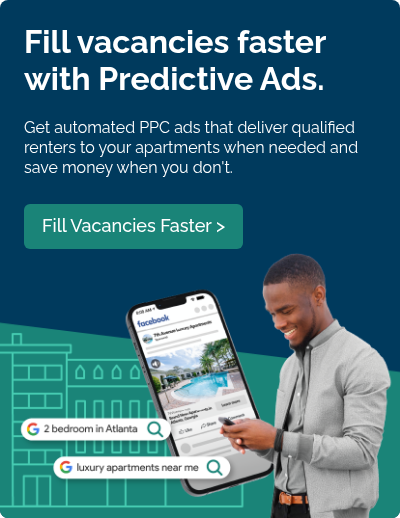Google Ads offer game-changing rewards for apartment marketers.
They're easily one of the most effective sources for connecting your apartments to interested renters at critical moments in their search.
But the truth is, starting in Google Ads for the first time is difficult.
We'll begin with the basics because you may not be able to reap the rewards of Google Ads without first understanding what all goes into them.
Follow this explainer guide to get a brief introduction to Google Ads for apartments and how they can significantly enhance leasing performance.
What is Google Ads?
Google Ads is a Pay-Per-Click (PPC) digital advertising platform that helps marketers create awareness, drive website traffic, and generate leads by placing targeted ads in front of the right audience at the right time.
For apartment marketers, Google Ads offers several ad formats, including text, image, and video ads.
These ads can appear on:
- Google’s search engine results page (SERP).
- YouTube.
- Google Maps.
- Gmail.
- Discovery.
- Over 2 million websites in the Google Display and Search Network(s).
Google Ads offers marketers exceptional control. You can decide the content of your ads, where they appear, and to whom they are shown.
You can adjust your budget dynamically to align with your goals, track near real-time performance data to measure success, and make necessary changes.
Okay, that's the high-level overview of Google Ads. Next, let's explain how apartment marketers can use them to connect with qualified renters.
How Apartment Marketers Can Use Google Ads
Apartment marketers can use Google Ads to connect with qualified renters in four key ways:
1. Search Ads
When a prospect goes to Google and searches for '2-bedroom apartments in downtown Kansas City,' search ads will appear at the top of the search engine results page for the apartment communities that bid for those keywords. These text-based ads include a compelling headline, display URL, description, and extensions such as a 'Call Now' button, link to directions, and sometimes a photo.
[Read: From Clicks to Renters: Crafting Multifamily Search Ads That Convert]
2. Display Ads
Display ads appear across a renter's browsing experience on websites outside the Google search engine—including websites and YouTube. These ads can take many forms—banners, video, or motion graphics—and feature high-quality visuals highlighting your community’s name, logo, amenities, and more. Display ads keep your property top-of-mind during a renter's apartment search by showcasing your brand at key moments.
3. YouTube Ads
Marketers can use photo and video display ads on YouTube to showcase their apartments. These ads can run as short, unskippable 6 to 15-second video bumpers or longer, skippable ads played before, during, or alongside YouTube videos. Additionally, display ads can be placed within the YouTube platform, such as above the menu of upcoming or recommended videos. Leveraging the best visuals of your unit interiors, amenities, and exteriors, or even using resident testimonials, helps create a strong emotional connection with renters.
4. Google Maps Ads
Many prospective renters will use Google Maps to perform discovery searches for apartments in their desired locations. Marketers can enhance their communities' presence with Google Maps ads, increasing visibility for their Google Business Profile card featuring photos, reviews, and contact details.
[Read: How to Attract Renters to Your Apartments Using Google Maps]
Does Google Ads produce results for apartment marketers?
Applying guarantees with digital advertising is tricky because every platform is different, and marketers are responsible for establishing strategies that consistently produce positive outcomes.
That said, there is a simple way to answer the question: Google generated $265 billion in ad revenue in 2024. If Google Ads had not worked on some level, they would not have produced that kind of revenue. The company prioritizes making its platform effective for advertisers.
As for that translating into success for apartment marketers, here's proof of the remarkable results Google Ads produced for one apartment community facing a vacancy crisis.
What does a successful Google Ads ad strategy for apartments look like?
Village West Apartments, a 200-plus-unit community, officially opened its doors in December 2020. Only ten months later, it completed its critical lease-up and raised rents while only having one leasing office staff member.
How? In addition to owning an engaging website that featured walkthrough video tours and floorplan-specific content (allowing renters to see the inside of particular units before they were available), Village West also utilized RentVision's predictive digital advertising solution. This solution automates PPC ad campaigns and spending based on a community's unique Future Occupancy so that the website receives the right amount of traffic at the right time.
Together, renters could successfully tour and apply for a lease online without seeing the apartments in person; hence, Village West signed 206 leases in 281 days with just one leasing agent.
In total, the community invested just over $15,000 combined on Google and Facebook advertisements during its ever-critical lease-up, which is roughly $35,000 less than the average salary of a leasing agent.
Village West consistently gained the right amount of highly qualified visitors to its website, leading to more engaged leads ready to rent an apartment—this is what a successful Google Ads strategy can do for multifamily properties (with or without the help of Facebook).
How do I budget for my apartments' Google Ads?
Unlike other static marketing tools, which can lock you into long-term contracts that level out the number of leads you receive each month (regardless of your community's occupancy), Google Ads has no fixed costs.
Still, you need to be smart about setting your Google Ad budgets. You want to make it possible to dynamically change spending according to your community's unique supply and demand to save money when your occupancy is strong.
For help, read our PPC ad budget guide here. In it, you can download a free tool that helps you set a dynamic budget that's adaptable to your community's unique needs.
How does Google determine when my apartment community's ads appear?
Google Ads is fundamentally different from other traditional mass-messaging forms of advertising.
The trouble is that many apartment marketers see Google Ads and mentally equate them with billboards on the side of a busy interstate.
If you're trying to generate as much visibility as possible for your apartments to the largest possible audience, it will cost you a lot of money (certainly more than a billboard) and produce bad traffic and leads.
A better strategy is to use Google Ads to target only relevant or specific keywords related to an apartment community. These relatively low-hanging fruits provide apartment marketers with real value at a fraction of the cost while ensuring their ads are shown to prospective renters looking for them.
To understand how Google determines when a specific community's ad appears and how you can earn the top spot in apartment searches, check out our guide here: How to Rank Higher in Apartment Searches with Google Ads.
What keywords should I target for my apartment community's Google Ads?
We'd recommend using tools such as Google's Keyword Planner (free), Google Search Console (free), or SEMRush (free-ish) to research the keywords you should target for your apartments.
Starting there will help you understand what renters are searching for when your apartment community is prominently featured on the search engine results page.
Select the right 'qualifier' keywords to boost your apartment's Google Ads.
Once you've targeted specific keywords for your apartments, the next step is to target keywords prospective renters typically enter when searching for a community like yours.
We call these keywords 'qualifiers' because they help your apartments achieve top placement in searches, and the results could be applied to multiple apartment communities.
Qualifier keywords you should focus on in your targeting strategy are:
- Location (ex. 'in/near downtown')
- Price (ex. '$1,200/month')
- Bed / Bath Count (ex. '2 bed / 2 bath')
- Policies (ex. 'pet-friendly')
- Property Type (ex. 'apartments'...Don't say 'condominiums'!)
- Property Class (ex. 'A class')
- Move-in Date (ex. 'Two months'...Don't say 'Now Leasing'; you're always leasing!)
- Property Descriptors (ex. 'modern')
- Amenities (ex. 'big gym')
The more qualifiers you have in your targeted keywords, the more valuable they are! Prioritizing high-volume search keywords with the right qualifiers relevant to your apartment community will significantly boost your Google Ads' performance.
Are there other features in Google Ads that apartment marketers can use to help their ads stand out?
There are! All ads use the same basic ad design template. Still, within that template, there is room for customization, primarily thanks to a feature called ad extensions.
Ad extensions allow you to add valuable details to your ads, improving engagement and performance. These include:
- Adding online review information.
- Adding location information.
- Adding a phone number. (On mobile devices, it will function as a push-to-call button that allows Google users to call your leasing office directly from the search result page.)
- Adding links to your site's pages, such as the floorplans pages, amenities page, or contact page.
Google recently added image extensions to ads, which are even more beneficial to apartment marketers who want to highlight their communities' exteriors, units, and amenities.
Pro tip: Extensions also function as a tie-breaker in the event of a tie on AdRank. In that case, if one ad uses extensions and one does not, the one that uses extensions will likely be placed higher.
Conclusion: Should apartment marketers use Google Ads? Yes!
Google Ads are an essential tool for apartment marketers. They allow you to control your community's visibility in search engines and can help you create a competitive advantage by displaying search, video, and image ads that capture prospective residents' interest and attention during each stage of their apartment search process.
Additionally, Google Ad campaigns are dynamic. You can use them to generate demand for your communities at the right time and safely dial down your spending when your occupancy is stable. They and other PPC advertisements are the only multifamily marketing source that allows you to make adjustments alongside the frequent changes to your communities' seasonality.
A great Google Ads strategy for your apartments ultimately helps sustain your occupancy year-round. You can get the right qualified visitors to your website precisely when needed and then save money when you don't.
Continued reading on digital advertising for apartments
- Our complete guide to digital apartment ads is a great place to start if you're looking to incorporate Google Ads, Facebook, or other channels into your multifamily marketing plan.
- Seem like a lot? Yeah, it is. That's why we created Predictive Advertising—the most effective digital advertising solution for multifamily. If you're looking for an easy-to-implement, smart advertising solution for your communities, you've come to the right place.


